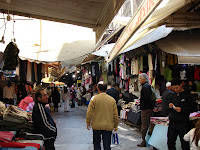

The teachers at Bob’s school take an annual spring educational holiday. Last year I went with them to Southern Italy, this year Bob and I both went with 35 other teachers and family members to Istanbul.
We left Wednesday evening with 2 holiday gift days from the school and returned on Sunday. We flew from Ljubljana at midnight with the Turkish truck drivers who load their trucks on tanker ships in Koper, Slovenija and then fly 2 hours to Istanbul to await their cargo. Once in Turkey the ride from the airport to Taksim square in the middle of the night gave us an unobstructed view of the city lit for the night; the Bosphorus river, the mosques and minarets, ancient walls of Constantinople and people gathering for kebabs and roasted chicken in the darkness. At first sight it was surprising the number of people casually wandering the streets in the early morning with the unexpected atmosphere of calm and safety linked by sweet smells.
Istanbul, known as Byzantium and then as Constantinople, is now a city of over 10 million people. Because of earthquakes the older buildings of the city are not tall, but they are crowded in together and piled on top of each other. The city has one foot in Europe and one in Asia spanning across the Bosphorus river that links the Black Sea with the Sea of Marmara and has been the seat of trade for thousands of years. Artifacts date settlements in this area from 5,500 BC and the history includes anyone who was anyone in the world [Ancient Greeks, Alexander the Great, Romans, Goths, Constantine, first church council at Nicaea, Theodosis I [same one who battled in the Vipava Valley in Slovenija], Justinian, missionaries from Byzantium to Slavic nations, Normans, Venetians, Turkic nomads, crusaders, Seljuk Turks, more pillaging crusaders, Ottoman Turks, countless Sultans, Sultanate women, more Sultans, Austrians, French and British soldiers and Greek forces]. Because of the influence of Mustafa Kemal Paşa [better known as Atäturk, “Father of the Turks”] Turkish land was reclaimed by the Turks, the sultanate was abolished in 1922, the country became a secular republic, the Arabic alphabet was replaced with the Roman alphabet, western dress was encouraged and all Turks were required to claim a surname. The red flag tells the story of the moon and one star reflected in the bloodshed of wounded Turkish soldiers fighting for independence. These are people proud of Turkey; proud of being Turkish and with every greeting they warmly welcomed us to their country.
Modern Istanbul a blend of new buildings, ancient remains, towering mosques, quaint cafés, crowds of people and stores, stores, and more stores. Little hidden stores the size of my bathroom, men with carts, men with card tables in the middle of the street, stores in basements, stores on side walks, stores in every nook and cranny and that is without even discussing the bazaars. It is obvious the Istanbul has been, and continues to be the mecca of trade, and buying and selling is a high art with rich social contact.




















